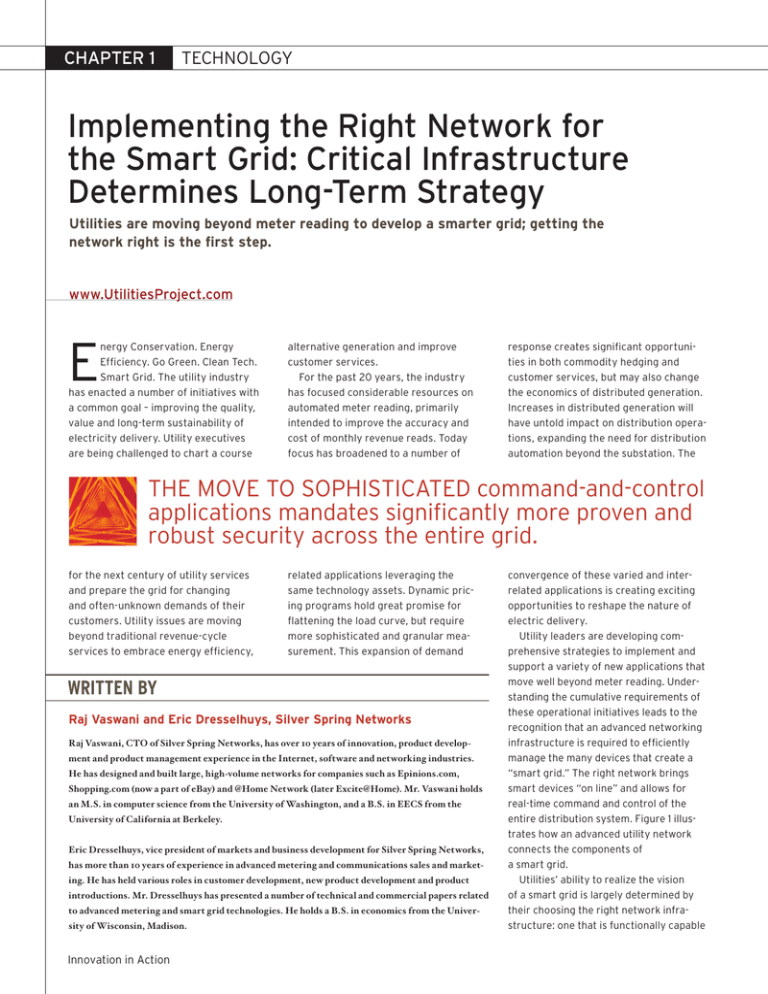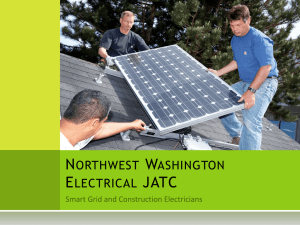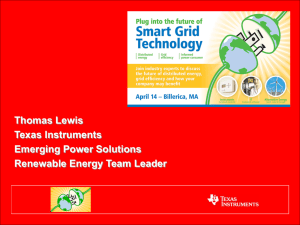Implementing the Right Network for the Smart Grid: Critical Infrastructure
advertisement

CHAPTER 1 TECHNOLOGY Implementing the Right Network for the Smart Grid: Critical Infrastructure Determines Long-Term Strategy Utilities are moving beyond meter reading to develop a smarter grid; getting the network right is the first step. www.UtilitiesProject.com E nergy Conservation. Energy Efficiency. Go Green. Clean Tech. Smart Grid. The utility industry has enacted a number of initiatives with a common goal – improving the quality, value and long-term sustainability of electricity delivery. Utility executives are being challenged to chart a course alternative generation and improve customer services. For the past 20 years, the industry has focused considerable resources on automated meter reading, primarily intended to improve the accuracy and cost of monthly revenue reads. Today focus has broadened to a number of response creates significant opportunities in both commodity hedging and customer services, but may also change the economics of distributed generation. Increases in distributed generation will have untold impact on distribution operations, expanding the need for distribution automation beyond the substation. The The move to sophisticated command-and-control applications mandates significantly more proven and robust security across the entire grid. for the next century of utility services and prepare the grid for changing and often-unknown demands of their customers. Utility issues are moving beyond traditional revenue-cycle services to embrace energy efficiency, related applications leveraging the same technology assets. Dynamic pricing programs hold great promise for flattening the load curve, but require more sophisticated and granular measurement. This expansion of demand WRITTEN BY Raj Vaswani and Eric Dresselhuys, Silver Spring Networks Raj Vaswani, CTO of Silver Spring Networks, has over 10 years of innovation, product development and product management experience in the Internet, software and networking industries. He has designed and built large, high-volume networks for companies such as Epinions.com, Shopping.com (now a part of eBay) and @Home Network (later Excite@Home). Mr. Vaswani holds an M.S. in computer science from the University of Washington, and a B.S. in EECS from the University of California at Berkeley. Eric Dresselhuys, vice president of markets and business development for Silver Spring Networks, has more than 10 years of experience in advanced metering and communications sales and marketing. He has held various roles in customer development, new product development and product introductions. Mr. Dresselhuys has presented a number of technical and commercial papers related to advanced metering and smart grid technologies. He holds a B.S. in economics from the University of Wisconsin, Madison. Innovation in Action convergence of these varied and interrelated applications is creating exciting opportunities to reshape the nature of electric delivery. Utility leaders are developing comprehensive strategies to implement and support a variety of new applications that move well beyond meter reading. Understanding the cumulative requirements of these operational initiatives leads to the recognition that an advanced networking infrastructure is required to efficiently manage the many devices that create a “smart grid.” The right network brings smart devices “on line” and allows for real-time command and control of the entire distribution system. Figure 1 illustrates how an advanced utility network connects the components of a smart grid. Utilities’ ability to realize the vision of a smart grid is largely determined by their choosing the right network infrastructure: one that is functionally capable white paper UTILITY Data Center ADVANCED UTILITY NETWORK Communications Gateway CUSTOMER PREMISE Relay Electric, Gas & Water Meters Figure 1 The right network infrastructure is key to realizing the vision of the smart grid. and cost-effective today, yet will support future (and often unknown) requirements. Advanced networking from the substation to – and into – the premise creates the fundamental platform on which smart grid initiatives are built. The right network infrastructure provides secure and seamless connectivity, supporting any utility application. Innovative, standards-based applications can leverage smart grid assets, turning new concepts into new products. The practice of a common network infrastructure supporting a number of applications is not new. For example, consider the Ethernet system installed in most offices. When the network was installed, it was intended to support a variety of applications, including email, Web browsing, video delivery and more. However, it was not necessary to decide up front all of the computers, printers or applications that would ever run over that network. By choosing a standardsbased network with the right performance characteristics, new technologies are easily and seamlessly incorporated onto the network. Utilities that make the right strategic decisions regarding the networking platform to deliver the smart grid will enjoy similar flexibility and business value creation. Failure to make the right networking choice may result in a utility’s future initiatives being hampered by the limitations of its network. Defining Your Smart Grid The first step in implementing the right network requires a utility to develop a strategic plan and define the technical, performance and price characteristics needed to support both current and future applications. Input from all areas of the utility operation should be included, as all departments are affected by – and can benefit from – the smart grid. Operational use cases that consider both current and anticipated needs should be reviewed, including representation from customer service, metering, distribution operations, information technology, revenue protection, regulatory and rate making. A considerable body of work is available to assist in this effort, including published documents from EPRI, GridWise and UtilityAMI. Critical Components of the Advanced Utility Network • Internet protocol (IP)-based networking • Transport-agnostic network technology • High security • Multi-application • Standards-based • Appropriately sized bandwidth Open, Not Closed Next, technical requirements of the advanced utility network need to be defined to support the operational requirements of the business. Given the variety of devices and interrelations between several applications, use of single-purpose or proprietary networking should be avoided. Implementing these technologies increases complexity and cost, while simultaneously decreasing long-term flexibility. Standardsbased networking is the safest, surest route when specifying the network infrastructure of the smart grid. The dominant standard in networking is Internet protocol, known simply as IP. Beyond the World Wide Web, IP is the networking standard used in managing nearly all telecommunications, cable and information technology applications. Hundreds of billions of dollars in collective research and development make IP the gold standard for mission-critical networking around the world. IP addresses many of the challenges of running multiple applications and devices on the same network. The IP suite delivers proven technologies for addressing, routing, quality of service and a host of related networking functions, all demonstrated at scale. With IP, vendors can compete to develop best-of-breed products for a variety of applications, yet share a common network infrastructure to minimize cost and complexity. www.UtilitiesProject.com Implementing the Right Network for the Smart Grid CHAPTER 1 TECHNOLOGY Security Via Proven Technology Historically, security in many remote utility applications consisted solely of “obscurity” created through the use of proprietary products or the use of simple passwords that were rarely changed. The move to sophisticated command-and-control applications mandates significantly more proven and robust security across the entire grid. A number of proven IP security technologies (for example, IPSEC or SSL) are available to address this need. These technologies are widely used in a number of industries, including securing financial transactions over the Web, to manage a range of security concerns. Most importantly, these technologies are constantly improving due to the collective efforts of countless vendors. IP suite security technologies allow utilities to effectively address concerns of spoofing, denial of service and unauthorized access without computers that connect using a variety of transports, it should be possible for a utility to choose the physical transport that best achieves the business case for any particular part of its service territory (for example, wireless for urban or suburban, powerline for rural). Such flexibility can be achieved by utilities in the same way that it is achieved by enterprises: by deploying standard, interoperable, IP-based products rather than proprietary, transportspecific ones. Performance: Bandwidth and Latency Two critical issues when developing the technical requirements of the smart grid network are those of available bandwidth and latency. Bandwidth is the volume of data per unit time that can move through the network. The first step in determining your requirements is to scope how much data is required from each device and be supported, nor would ever be necessary. The history of networking, however, suggests that if additional data is made available, customers will always find a use for it. For example, over time, public websites have migrated from serving small text pages of a few KBs, to rich graphical pages of hundreds of KBs, to streaming audio and video at tremendous data rates. These innovations are made possible by the availability of economical but rapidly growing Internet bandwidth. Solutions from the traditional IP-based networking world, deployed in utility networks today, render it possible for utilities to move and manage much larger amounts of data than heretofore possible. It is no longer necessary for utilities to constrain their business operations – or for that matter, their imaginations – based on the limitations of their vendors’ technology. Latency is equally important. Many smart grid applications, including distri- A standards-based network ensures that the explosion of new utility and consumer devices can easily be incorporated into the smart grid. the requirement of reinventing new technologies or relying on the efforts of a single vendor. Transport Independence Application vendors have historically been defined by the physical medium of their solution. A vendor might be “wireless” or “powerline,” but rarely both. Over the past few years, there has been a dizzying increase in the number of available carrier solutions, including WiFi, Wi-Max, Zigbee, Z-wave, DS2, Homeplug, a variety of cellular standards and more. Each of these “standards” (reflecting Layer 1 and Layer 2 of the ISO seven-layer stack) offers different advantages and disadvantages. A similar set of choices exists in enterprise IT infrastructure. For example, office computers may connect to the enterprise network either via WiFi or wired Ethernet. In the same way an enterprise can choose Innovation in Action application. Add them up on a timesensitive basis. Where are the peaks? Where does it break? Does the solution allow you to add bandwidth if needed in the future? Although smart grid applications generate significantly more data than monthly meter reading and historic low-density, one-way demand response applications, it is not a large volume of data relative to modern IT systems. Take the very familiar example of a manual meter read: Manual meter reading generates approximately 30 bytes per month of data, per customer. A new smart meter, collecting multichannel, 15-minute interval data with event logs, security logs, power quality and other measures might generate over 10,000 times as much – perhaps 50 to 60 KB of data per meter, per day. In an environment of applicationspecific, low-bandwidth solutions, it may seem that this much data could never bution automation, outage alarming and load control signaling, require very low latency, while others, such as metering, are more latency-tolerant. Smart grid networking needs to support end-to-end and device-to-device latencies not of minutes or hours, but of seconds and milliseconds. To manage traffic appropriately, networking technology must support message prioritization, allowing critical, latencyintolerant messages primacy to other network traffic. For example, meter- reading acquisition is generally expected only within a time window measured in minutes or hours, while some DA applications require that remote devices talk “across” the network (without routing through the back office) in less than a second. Cost/Performance Balance Drives Value Hardware economics historically limited the deployment of multi-application white paper networks, forcing utilities to implement vertically integrated, application-specific solutions. While these solutions often solved immediate needs, they also created significant back-office integration issues, increased operational complexity and increased long-term costs. Many utilities hoped that solutions offering greater bandwidth, such as broadband over powerline (BPL) would address this need. Although BPL delivered strong functional performance, the infrastructure costs were measured in hundreds of dollars per home passed, far exceeding the value to be gained from utility applications alone. Current hardware economics now make it possible to deliver high-bandwidth, low-latency networking at reduced cost. It is now possible to deploy a systemwide networking infrastructure delivering hundreds of Kbps and sub-second latencies at a fraction of the cost of broadband. Specific pricing varies based on utility specifics, but can typically rival traditional AMR/AMI network pricing. This results in the utility realizing significantly greater benefits from a variety of applications while simultaneously saving 30 to 40 percent in operational costs versus operating separate communications solutions for each application. become available and utilities will need to connect them. Build It Right – Not Over Less than 20 years ago, laptops, ubiquitous cell phones, iPods and Xboxes were not in existence. Considering the emergence of new utility applications and devices, it is hard to imagine what is to come in the next five to 10 years. Even today, there is an explosion of new utility and consumer devices, including remote controllable thermostats, consumer-based energy storage appliances, customer displays, fault indicators, distribution automation applications and more. Regardless of the applications or devices that emerge, a standards-based network ensures that they can easily be incorporated into the smart grid. As exhibited in other industries, including cable, IT and telecom, a robust and flexible network is the basis for competitive advantage. An IP-based network allows a utility to network devices not yet invented, if they are built on IP. Product development cycles for devices are much faster than the life cycle of the network, so one must expect new devices will The Right Network Utilities around the world are now leading the drive to capture energy efficiency as the “fifth fuel.” Smart grid applications including advanced metering, demand response, distributed generation and distribution automation offer utilities all the tools to capture this value. By specifying and implementing the right networking infrastructure, utilities are building a strategic technology platform that enables a wide range of policy and business initiatives for years to come, avoiding concerns of near-term obsolescence or functionally bridling technologies. IP-based networking is really the only choice when building the network infrastructure for the future. n WEBLINK >>>>> More information and additional material can be found online at www.UtilitiesProject.com/XXXXX www.UtilitiesProject.com



